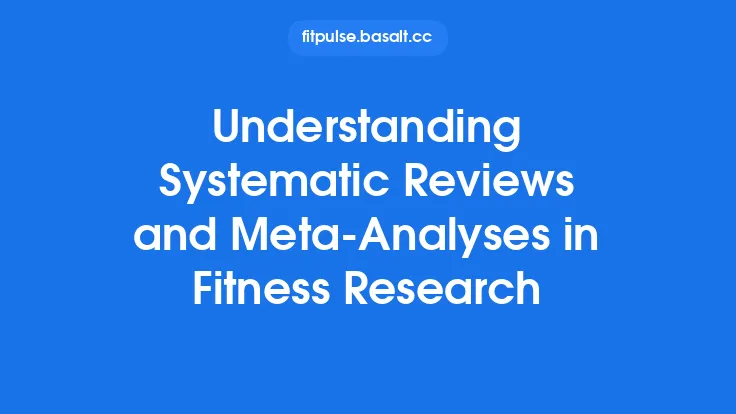The rapid convergence of wearable technology and big‑data analytics is reshaping how exercise scientists design studies, capture physiological signals, and interpret complex patterns of human movement. Unlike traditional laboratory‑based protocols that rely on isolated measurements and relatively small cohorts, modern approaches enable continuous, ecologically valid monitoring of thousands of participants in real‑world settings. This shift not only expands the scope of questions that can be addressed but also demands new methodological rigor, interdisciplinary collaboration, and robust data‑handling pipelines. Below, we explore the core components of this emerging research paradigm, from sensor selection and data acquisition to advanced analytical techniques and future directions.
The Evolution of Wearable Sensors in Exercise Science
From Simple Pedometers to Multi‑Modal Platforms
Early wearables such as pedometers provided a single metric—step count—derived from a basic accelerometer. Contemporary devices integrate multiple sensing modalities, including:
| Sensor Type | Primary Output | Typical Placement | Example Applications |
|---|---|---|---|
| Triaxial Accelerometer | Linear acceleration (g) | Wrist, hip, thigh | Activity classification, gait analysis |
| Gyroscope | Angular velocity (°/s) | Wrist, ankle | Postural control, sport‑specific technique |
| Magnetometer | Magnetic field orientation | Wrist, chest | Heading detection, navigation |
| Photoplethysmography (PPG) | Heart rate, HRV | Wrist, finger | Cardiovascular load, recovery monitoring |
| Electrodermal Activity (EDA) | Skin conductance | Wrist, palm | Stress and autonomic response |
| Inertial Measurement Unit (IMU) (combined accel‑gyro‑mag) | Full motion capture | Lower back, shank | Kinematic profiling, joint angle estimation |
| GPS / GNSS | Position, velocity, altitude | Chest strap, shoe | Outdoor running, cycling performance |
| Near‑Infrared Spectroscopy (NIRS) | Muscle oxygenation | Upper arm, thigh | Local metabolic demand |
The integration of these sensors into a single, lightweight platform allows researchers to capture a rich, synchronized dataset that reflects both external workload and internal physiological response.
Signal Quality and Calibration
High‑quality data depend on proper sensor calibration and placement. Calibration protocols typically involve:
- Static Calibration – Recording known reference positions (e.g., standing still) to correct bias and scale factors.
- Dynamic Calibration – Using controlled movements (e.g., treadmill walking at known speeds) to validate sensor fusion algorithms.
- Cross‑Validation – Comparing wearable outputs against gold‑standard laboratory equipment (e.g., motion capture, indirect calorimetry) to quantify measurement error.
Documenting these procedures in publications enhances reproducibility and facilitates meta‑analytic synthesis of wearable‑derived outcomes.
Data Acquisition Strategies for Large‑Scale Studies
Sampling Frequency Trade‑offs
Higher sampling rates (e.g., 100–200 Hz for IMUs) capture fine‑grained kinematic details but increase storage and battery demands. Researchers must balance:
- Temporal Resolution Needs – Fast, ballistic movements (e.g., sprinting) require ≥ 100 Hz; slower activities (e.g., walking) can be adequately captured at 20–50 Hz.
- Battery Life Constraints – Longer monitoring periods (≥ 24 h) may necessitate lower rates or intermittent recording.
- Data Transmission – Real‑time streaming via Bluetooth Low Energy (BLE) or Wi‑Fi can be limited by bandwidth; batch uploads after recording are often more reliable for large cohorts.
Cloud‑Based Data Management
Modern studies frequently employ cloud platforms (e.g., AWS, Google Cloud, Azure) for:
- Scalable Storage – Object storage (S3, Blob) accommodates terabytes of raw sensor files.
- Automated Ingestion Pipelines – Serverless functions (Lambda, Cloud Functions) parse incoming data, apply initial quality checks, and route files to appropriate databases.
- Secure Access Controls – Role‑based permissions and encryption at rest/in‑transit protect participant confidentiality.
Standardized data schemas (e.g., JSON‑based “Wearable Data Model”) facilitate downstream analysis and enable data sharing across institutions.
Pre‑Processing and Feature Extraction
Signal Conditioning
Raw sensor streams often contain noise, drift, and motion artifacts. Common preprocessing steps include:
- Low‑Pass Filtering – Butterworth or Chebyshev filters (cut‑off 5–20 Hz for accelerometry) to remove high‑frequency noise.
- High‑Pass Filtering – Eliminates gravitational offset for dynamic acceleration analysis.
- Sensor Fusion – Kalman or complementary filters combine accelerometer, gyroscope, and magnetometer data to produce stable orientation estimates.
- Artifact Detection – Algorithms flag implausible spikes or signal loss (e.g., sudden zero‑value periods) for manual review or automatic interpolation.
Feature Engineering
From conditioned signals, researchers derive time‑domain, frequency‑domain, and nonlinear features:
- Time‑Domain: Mean, standard deviation, root‑mean‑square (RMS), peak amplitude, step count.
- Frequency‑Domain: Power spectral density (PSD), dominant frequency, spectral entropy.
- Nonlinear: Sample entropy, detrended fluctuation analysis, recurrence quantification.
These features serve as inputs for classification models (e.g., activity type) or regression models (e.g., energy expenditure).
Big‑Data Analytics in Exercise Science
Machine Learning for Activity Classification
Supervised learning pipelines typically follow:
- Label Acquisition – Ground truth obtained via video annotation or laboratory reference devices.
- Training Set Construction – Balanced representation of activity classes (e.g., walking, running, cycling, resistance training).
- Model Selection – Random forests, support vector machines, and deep convolutional neural networks (CNNs) have demonstrated high accuracy (> 90 %) for wearable‑based activity recognition.
- Cross‑Validation – K‑fold or leave‑one‑subject‑out validation mitigates overfitting and assesses generalizability.
Predictive Modeling of Physiological Outcomes
Beyond classification, regression models predict continuous outcomes such as:
- Energy Expenditure – Using linear regression, gradient boosting, or recurrent neural networks (RNNs) to map sensor features to metabolic equivalents (METs).
- Cardiovascular Load – Estimating VO₂max or lactate threshold from HRV and accelerometry patterns.
- Injury Risk – Identifying biomechanical markers (e.g., asymmetrical loading) that correlate with musculoskeletal injury incidence.
Model interpretability tools (SHAP values, permutation importance) help researchers understand which sensor features drive predictions, informing both scientific insight and practical monitoring strategies.
Population‑Scale Analyses
When datasets encompass thousands to millions of participants, statistical techniques shift toward:
- Mixed‑Effects Modeling – Captures within‑subject variability while accounting for hierarchical data structures (e.g., repeated measures nested within individuals).
- Survival Analysis – Evaluates time‑to‑event outcomes such as injury occurrence or dropout, incorporating time‑varying covariates derived from wearables.
- Network Analysis – Constructs interaction graphs (e.g., co‑activity networks) to explore community-level behavior patterns and their relationship to health outcomes.
These approaches leverage the breadth of big data while preserving the nuance of individual-level measurements.
Validation and Standardization Frameworks
Benchmark Datasets
Open repositories (e.g., UCI HAR, PAMAP2, MHealth) provide standardized benchmarks for algorithm development. Researchers are encouraged to:
- Report Performance on Multiple Benchmarks – Demonstrates robustness across sensor configurations and activity repertoires.
- Contribute New Datasets – Sharing annotated, real‑world recordings expands the collective resource pool and accelerates methodological progress.
Reporting Guidelines
Adhering to emerging reporting standards (e.g., “Wearable Sensor Reporting Checklist”) ensures transparency. Key elements include:
- Device make/model, firmware version, and sensor specifications.
- Placement protocol (exact anatomical location, attachment method).
- Calibration procedures and validation results.
- Data preprocessing pipeline (filter parameters, artifact handling).
- Feature extraction methods and software libraries used.
Consistent reporting facilitates replication and meta‑analysis without overlapping with the critical‑evaluation topics covered in neighboring articles.
Ethical and Privacy Considerations (Methodological Focus)
While the primary focus of this article is methodological, it is essential to embed privacy‑preserving practices within the research workflow:
- Data Anonymization – Remove personally identifiable information (PII) before storage; apply techniques such as differential privacy when sharing aggregated results.
- Informed Consent for Continuous Monitoring – Clearly articulate data collection duration, types of data captured, and potential secondary uses.
- Secure Data Transfer – Use encrypted channels (TLS) for device‑to‑cloud communication; implement token‑based authentication for API access.
Embedding these safeguards at the design stage reduces downstream compliance burdens and protects participant trust.
Challenges and Limitations
| Challenge | Description | Mitigation Strategies |
|---|---|---|
| Sensor Drift & Calibration Decay | Long‑term wear leads to gradual changes in sensor bias. | Periodic recalibration, use of reference events (e.g., known postural changes). |
| Missing Data | Connectivity loss or device removal creates gaps. | Imputation methods (e.g., Kalman smoothing), redundancy via multiple sensors. |
| Inter‑Device Variability | Different manufacturers may report divergent values for the same metric. | Cross‑device validation studies; use of device‑agnostic features (e.g., normalized acceleration). |
| Data Overload | High‑frequency recordings generate massive files. | Edge computing for on‑device feature extraction; selective down‑sampling. |
| Algorithm Generalizability | Models trained on specific populations may not transfer. | Diverse training cohorts; transfer learning techniques. |
Recognizing these constraints guides realistic study design and informs the interpretation of findings.
Future Directions
Multimodal Fusion with Physiological Imaging
Combining wearables with portable imaging modalities (e.g., ultrasound, near‑infrared spectroscopy) promises deeper insight into muscle mechanics and metabolic responses during free‑living activity.
Edge‑AI for Real‑Time Feedback
Embedding lightweight neural networks on the device itself enables instantaneous coaching cues (e.g., cadence correction) without reliance on cloud connectivity.
Longitudinal Cohort Studies Powered by Passive Monitoring
Large-scale, multi‑year investigations can track lifestyle trajectories, linking habitual activity patterns captured by wearables to chronic disease outcomes, thereby bridging the gap between acute exercise trials and public‑health research.
Open‑Science Platforms for Wearable Data
Community‑driven repositories that host raw sensor streams, metadata, and analysis scripts will accelerate methodological innovation and foster reproducibility across laboratories.
Practical Takeaways for Researchers
- Define the Research Question First – Choose sensor modalities that directly address the physiological or biomechanical construct of interest.
- Pilot Test the Full Pipeline – From device wear to cloud ingestion, ensure each step functions reliably before scaling.
- Document Every Parameter – Calibration, placement, sampling rate, and preprocessing choices should be recorded in a reproducible format (e.g., Jupyter notebooks, R markdown).
- Leverage Existing Toolkits – Open‑source libraries such as `pywearable`, `mne‑python`, and `TensorFlow Lite` reduce development time.
- Plan for Data Governance – Establish clear data‑ownership agreements, storage policies, and participant consent pathways early in the project lifecycle.
By integrating robust wearable technologies with sophisticated big‑data analytics, exercise scientists can capture the complexity of human movement in unprecedented detail. This methodological evolution not only expands the horizons of inquiry but also lays the groundwork for personalized, data‑driven approaches to health and performance.





